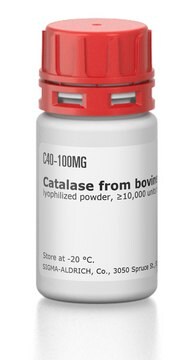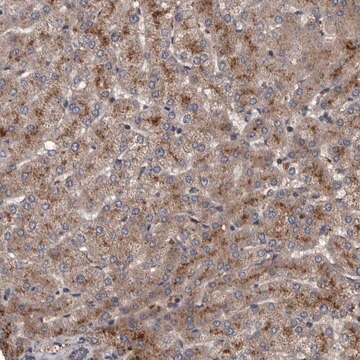ABT1346
Anti-Bikunin (CP6)
serum, from rabbit
Synonyme(s) :
Protein AMBP, alpha-1-microglobulin/bikunin precursor, Inter-alpha-trypsin inhibitor light chain, ITI-LC, Bikunin, EDC1, HI-30, Uronic-acid-rich protein
About This Item
Produits recommandés
Source biologique
rabbit
Niveau de qualité
Forme d'anticorps
serum
Type de produit anticorps
primary antibodies
Clone
polyclonal
Espèces réactives
human, mouse
Réactivité de l'espèce (prédite par homologie)
porcine (based on 100% sequence homology), camel (based on 100% sequence homology), nonhuman primates (based on 100% sequence homology), feline (based on 100% sequence homology)
Technique(s)
western blot: suitable
Numéro d'accès NCBI
Numéro d'accès UniProt
Conditions d'expédition
ambient
Modification post-traductionnelle de la cible
unmodified
Informations sur le gène
human ... AMBP(259)
Description générale
Spécificité
Immunogène
Application
Cell Structure
Western Blotting Analysis: A representative lot detected ~132 kDa Pre-IαI (PαI, bikunin·HC3) in murine airway epithelial cell (AEC) lysate (Abbadi, A., et al. (2015). J. Biol. Chem. 291(3):1448-1455).
Western Blotting Analysis: A representative lot detected ~37 kDa human urine bikunin, as well as the in vitro generated ~125 kDa PαI (bikunin·HC3) by TNF-stimulated gene 6-/TSG-6-catalyzed transfer of a single heavy chain (HC) from mouse serum to the glycosaminoglycan of bikunin using either human urine or purified human urine bikunin (Lamkin, E., et al. (2015). J. Biol. Chem. 290(8):5156-5166).
Immunohistochemistry Analysis: A representative lot localized bikunin immunoreactivity in 10% formalin-fixed (48 h), 5% EDTA-decalcified (14 days), paraffin-embedded human femoral condylar cartilage sections (Yoshihara, Y., et al. (2008). Osteoarthritis Cartilage. 16(11):1343-1355).
Qualité
Western Blotting Analysis: A 1:500 dilution of this antiserum detected bikunin immunoreactive bands (IαI & PαI) in 44.8 µg of mouse serum proteins.
Description de la cible
Forme physique
Stockage et stabilité
Handling Recommendations: Upon receipt and prior to removing the cap, centrifuge the vial and gently mix the solution. Aliquot into microcentrifuge tubes and store at -20°C. Avoid repeated freeze/thaw cycles, which may damage IgG and affect product performance.
Autres remarques
Clause de non-responsabilité
Vous ne trouvez pas le bon produit ?
Essayez notre Outil de sélection de produits.
Code de la classe de stockage
12 - Non Combustible Liquids
Classe de danger pour l'eau (WGK)
WGK 1
Point d'éclair (°F)
Not applicable
Point d'éclair (°C)
Not applicable
Certificats d'analyse (COA)
Recherchez un Certificats d'analyse (COA) en saisissant le numéro de lot du produit. Les numéros de lot figurent sur l'étiquette du produit après les mots "Lot" ou "Batch".
Déjà en possession de ce produit ?
Retrouvez la documentation relative aux produits que vous avez récemment achetés dans la Bibliothèque de documents.
Notre équipe de scientifiques dispose d'une expérience dans tous les secteurs de la recherche, notamment en sciences de la vie, science des matériaux, synthèse chimique, chromatographie, analyse et dans de nombreux autres domaines..
Contacter notre Service technique








